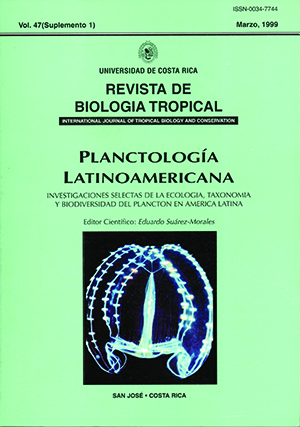Resumen
Este estudio pretende contribuir al conocimiento del patrón reproductivo de Artemia de Bahía de Ceuta, Sinaloa y de las salinas de Yavaros, Sonora; aunado a los conocimientos ya generados de estas poblaciones, será útil para proponer opciones que aumenten la fertilidad de las mismas al ser cruzadas con A. franciscana de Bahía de San Francisco, California, para incrementar los rendimientos en sus posibles cultivos.Citas
Amat. F.D. 1984. Diferenciación y distribución de las poblaciones de Anemia (Crustáceo-Branquiópodo) de España. Intercanvi. Cientific 1 Extensio Universitaria. Universitat de Barcelona. 25 p.
Barata. C., F. Hontoria., F. Amat & R. Browne. 1996. Demographic parameters of sexual and parthenogenetic Artemia: temperature and strain effects. J. Exp. Mar. Biol. Ecol. 196: 329-340.
Bravo, G.C. 1997. Caracterización morfométrica y reproductiva de la población mexicana de Anemia sp. presente en la "Bahía de Ceuta". Sinaloa. México; e hibridación con Artemia franciscana. Tesis de Licenciatura. Universidad Autónoma Metropolitana-Xochimilco. CBS. Distrito Federal. México. 47 p.
Browne. R.A., L. E. Davis & S.E. Salle. 1988. Effects of temperature and relative fitness of sexual and asexual-brine shrimp Artemia. J. Exp. Mar. Biol. Ecol. 124: 1-20.
Browne, R.A, S. E. Salle, D. S. Grosch., W. O. Segreti & S. M. Purser. 1984. Partitioning genetic and environmental components of reproduction and lifespan in Artemia. Ecology 65: 949-960.
Castro, M. G., J. Castro, A. Malpica; R. De Lara & T. Castro. 1996. Aspectos del comportamiento biológico de Artemia franciscana de la población de Yavaros, Sonora, cultivada en diferentes salinidades. Oceanología 12:7-13.
Correa, S.F. & Bückle, R.L.F. 1993. Morfología y biometría de cinco poblaciones de Artemiafranciscuna (Anostraca: Artemiídae). Rev. Biol. Trop. 41: 103-110.
Gallardo, C. & J.Castro. 1987. Reproduction and genetics of mexicanArtemia. p. 249-253. In: P. Sorgeloos; D. Bengtson; W. Decleir y E. Jaspers. (Eds.) Artemia research and its applications. Vol. 1. Morphology, Genetics, Strain characterizatíon. Universa Press. Wetteren, Bélgica. 359 p.
Dana, G. L., R. Jellison, J.M. Melack & G. L. Starrett. 1993. Relationships between Artemia monica life history characteristics and salinity. Hydrobiologia
: 129-143.
Forbes, M.R.L., H.Pagola & R.L.Baker. 1992. Causes of a non-random pairing by size in the brine shrimp, Artenúa salina: (Crustacea:Anostraca). Oecología
:214-219.
Kuruppu. M.M. & S. U. K. Ekaratne. 1995. Effects of temperature and salinity on survival, growth and fecundity of the hrine shrimp Artemia arthenogenetica
from Sri Lanka. J. Natl. Sci. Conne.- Sri Lanca 23:161-169.
Lochhead, JA & M.S. Lochhead. 1940. The eggshells of the brine shrimp Artemia. Ana. Rec. 78 (4 Suppl.): 75-76
López, CJ. 1997. Caracterización morfométIica y reproductiva de la población mexicana de Anemia sp. presente en la salina 'Tres Hermanos", Yavaros, Sonora, México: e hibridación con Artemia Franciscana. Tesis de Licenciatura. Universidad Autónoma Metropolilana-Xochimilco. CBS. Distrito Federal. México.
p.
Malpica, S,A, J. Castro, G,L. Rodríguez, T. Castro, C. Gallardo & R. De Lara 1995, Características de la reproducción y del periodo de vida en las hembras de la población de Artemia spp, de la salina "Las Coloradas", Oaxaca, en condiciones de laboratorio, Oceanología 3: 127-133.
Nimura, Y, K. Nanba & M, I. Miab, 1994, Food utilization in Artemia [rom growth, reproduction, and maintenance. Fisheries Science (Tokyo) 60: 493-
Sorgeloos, P., Lavens, P. Léger, Ph., Tackaert, W. & Versichele, D. (1986). Manual for the culture and use of bline shrimp Artemia in aquaculture. State University of Ghent, Bélgica, 319 p.
Triantaphyllidis, G. V, K. Poulopoulou., T.J, Abatzopoulos., C.A. Pinto-Pérez & P. Sorgeloos. 1995, Salinity effects on survival, maturity, growth, biometrics, reproductive and lifespan characleristics of a bisexual and parthenogenetic population of Artermia. Hydrobiologia 302: 215-227,
Wang, R. & R. Zhang, 1995, Effect, of temperature and salinity on the biological character of Anemia strains, Acta Ecol. Sin, Shengtai Xuebao 15: 214-220.
##plugins.facebook.comentarios##

Esta obra está bajo una licencia internacional Creative Commons Atribución 4.0.
Derechos de autor 1999 Revista de Biología Tropical


